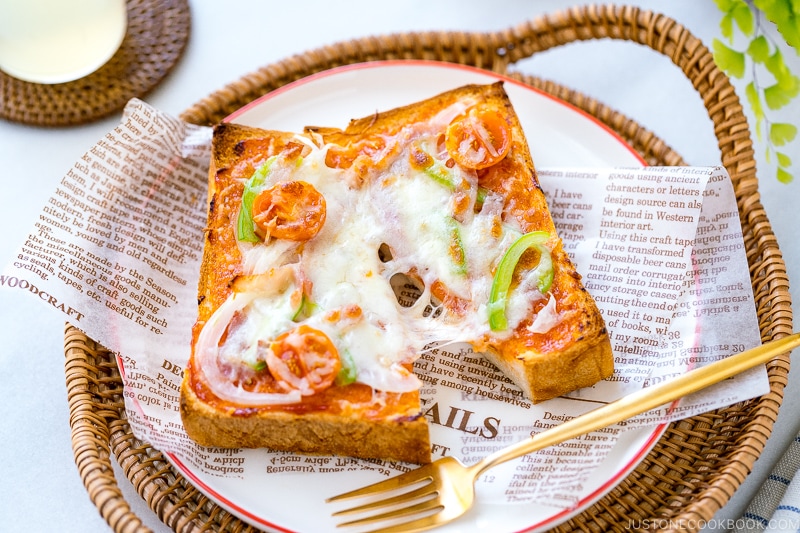Japanese Pizza Toast Recipe: A Delicious Childhood Comfort Food
Core Concepts
This content highlights the history, ingredients, and steps to make Japanese pizza toast, a popular childhood comfort food in Japan.
Abstract
Chunky slices of Japanese milk bread topped with homemade pizza sauce, salty ham, fresh veggies, and melty mozzarella cheese create the nostalgic and delicious Japanese Pizza Toast. Originating from a Tokyo coffee shop in 1964, this simplified version of pizza has become a beloved lunch or snack item in Japan. The recipe involves using Japanese milk bread as the base canvas for various toppings like onion, bell pepper, ham, and cherry tomatoes. Tips include cutting ingredients thinly and making homemade pizza sauce for enhanced flavors.
Customize Summary
Rewrite with AI
Generate Citations
Translate Source
To Another Language
Generate MindMap
from source content
Visit Source
www.justonecookbook.com
Pizza Toast ピザトースト
Stats
15 minutes is all it takes to make Japanese Pizza Toast.
In 1964, a coffee shop in Tokyo introduced a simpler version of pizza using milk bread.
Ingredients include Japanese milk bread (shokupan), pizza sauce, mozzarella cheese, onion, green bell pepper, ham (sausage/salami/bacon), and cherry tomatoes.
Other topping ideas include corn, mushrooms, and olives.
Tips include cutting ingredients thinly and making homemade pizza sauce for better flavors.
Quotes
"Even a child can tell you that bread, cheese, and tomato sauce make some really yummy food."
"Pizza toast is truly special on its own."
"Ketchup on toast is a thing in Japan."
Key Insights Distilled From
by Author at www.justonecookbook.com 07-06-2022
https://www.justonecookbook.com/pizza-toast/
Deeper Inquiries
How has the popularity of Japanese pizza toast evolved over time?
The popularity of Japanese pizza toast has evolved significantly over time. Initially introduced in 1964 as a simpler and more affordable alternative to traditional pizza, it quickly gained traction due to its delicious taste and ease of preparation. As pizza was considered a luxury food item in Japan at that time, the introduction of pizza toast made this beloved dish accessible to a wider audience. Over the years, Japanese pizza toast has become a staple snack and lunch option for both children and adults in Japan. Its convenience, nostalgic appeal, and unique twist on classic flavors have contributed to its enduring popularity.
What are some potential drawbacks or criticisms of using milk bread as the base for pizza toast?
While milk bread serves as an excellent base for Japanese pizza toast with its sweet, soft texture, there are some potential drawbacks or criticisms associated with using it. One drawback is that milk bread may not provide the same structural integrity as traditional pizza dough, leading to a softer crust that might not hold up well under heavy toppings. Additionally, some individuals may find the sweetness of milk bread conflicting with savory toppings typically found on pizzas.
Critics might argue that using milk bread deviates too far from the authentic Italian concept of pizza by replacing traditional crust with a different type of bread altogether. Purists may prefer sticking to conventional ingredients when making pizzas rather than opting for variations like using milk bread.
How does the cultural significance of comfort foods vary between different regions globally?
Comfort foods hold significant cultural importance across various regions globally but can differ based on culinary traditions, historical influences, and local preferences. In many Western countries like the United States or Italy, comfort foods often revolve around hearty dishes like macaroni and cheese or pasta carbonara that evoke feelings of nostalgia and warmth.
In Asian cultures such as Japan or South Korea, comfort foods tend to include rice-based dishes like congee or bibimbap which offer familiarity and emotional solace during times of stress or homesickness. These dishes are deeply rooted in tradition and family customs.
Furthermore, regional variations exist within countries themselves; for example, Southern cuisine in the U.S. emphasizes fried chicken and biscuits while Northern cuisine leans towards clam chowder and lobster rolls.
Overall, comfort foods serve as culinary touchstones that connect individuals to their heritage while providing a sense of security and belonging regardless of where they are located geographically.
0
